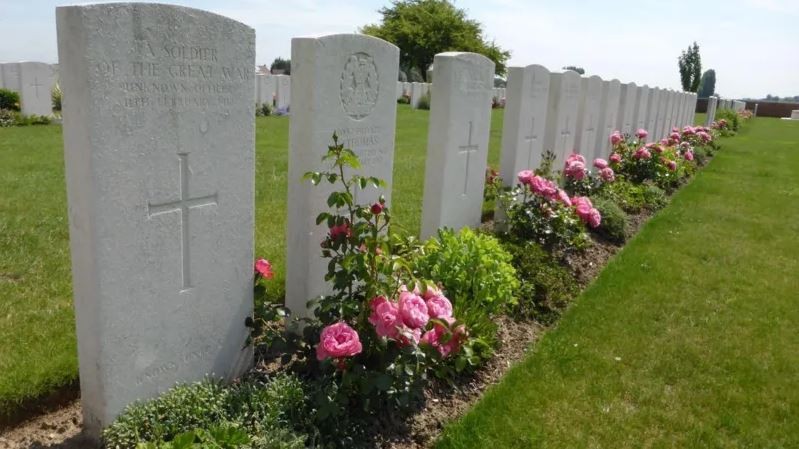
(Photo: David Tattersfeld/BBC)
An officer and 12 enlisted men of the 4th Tyneside Scottish Battalion were recently discovered over a century after they and nine others fell during a trench raid in France.
According to the BBC, only nine of the 22 men were buried in named graves, while the remaining 13 were buried unidentified in Rue-Petillon cemetery in France until their discovery, which was announced this year.
The grave of one of the battalion's officers, Capt. Cedric Daggett was rededicated to him at a ceremony at the cemetery on Tuesday (Mar. 19).
The Western Front Association's David Tattersfield told the BBC that his group had identified the missing soldiers after spotting their graves while in France and becoming interested in the men when they noticed that all of them died on the same date.
"I did the research and discovered that there [was] only one particular group of men who this could possibly be," he said. "There were not an awful lot of over-the-top, big, set-piece battles that took place in the First World War in the winter. I narrowed it down to this particular unit, which [was] known as the Tyneside Scottish, or more particularly, the 23rd Northumberland Fusiliers."
The organization is composed of people interested in everything that happened during the Great War, as the First World War was previously called.
The Tyneside Scottish was originally formed of men of Scottish descent from in and around Newcastle, but it expanded to include men from outside the area after the battalion suffered heavy losses.
The soldiers were initially buried in a German cemetery near the French city of Lille before later moving them to Rue-Petillon by the Commonwealth War Graves Commission.
"A hundred years later I rocked up and identified that there was a story here, because they were all connected," Tattesfield explained, adding that he then contacted the British Ministry of Defense's Joint Casualty and Compassionate Center with his research.
The department eventually confirmed the unnamed officer's grave belonging to Capt. Daggett.
Read Also: Delta Pilot Who Tried to Fly Across Atlantic Drunk on Jägermeister Gets 10 Months Behind Bars
The 12 previously-unknown enlisted men under Dagett's command were the following:
- Sgt. Albert Robinson, from Durham
- L/Cpl. John Dockerty, from Bedlington, Northumberland
- Pvt. Robert Banks, from Patrington, East Yorkshire
- Pvt. Robert Charlton, from Monkseaston, Northumberland
- Pvt. Henry Clarke, from Kirkby Lonsdale, Cumbria
- Pvt. John Collett, from Leeds
- Pvt. Frederick Hammond, from Hollow Meadows, South Yorkshire
- Pvt. John Hart, from Hull
- Pvt. Edward Jenkins, from Leominster
- Pvt. John Stamper, from Huddersfield
- Pvt. Joseph Storey (who served under the alias Robson) from Gateshead
- Pvt. David Walling, from Barnoldswick, Yorkshire
Pvt. Reginald Thomas was also buried in Rue-Petillon after dying of his wounds a few days after the trench raid that killed Daggett and his men. He was one of the identified men during the military action and was buried with a named headstone.
As an officer, Dagett's grave was the only one to be formally rededicated by the British defense ministry, but Tattersfield stressed that the other unknown graves belonged to those who served with the officer in the Tyneside Scottish, which meant that the relatives of the men were also invited to attend the rededication ceremony at Rue-Petillon.
In addition to Daggett, the grave of Pvt. Harold Stanley Harvey of The Middlesex Regiment (Duke of Cambridge's Own) was also identified and rededicated.
Related Article: Nuclear Dud: Trident Missile Misfires in Test Launch Aboard UK's Vanguard-Class Sub









